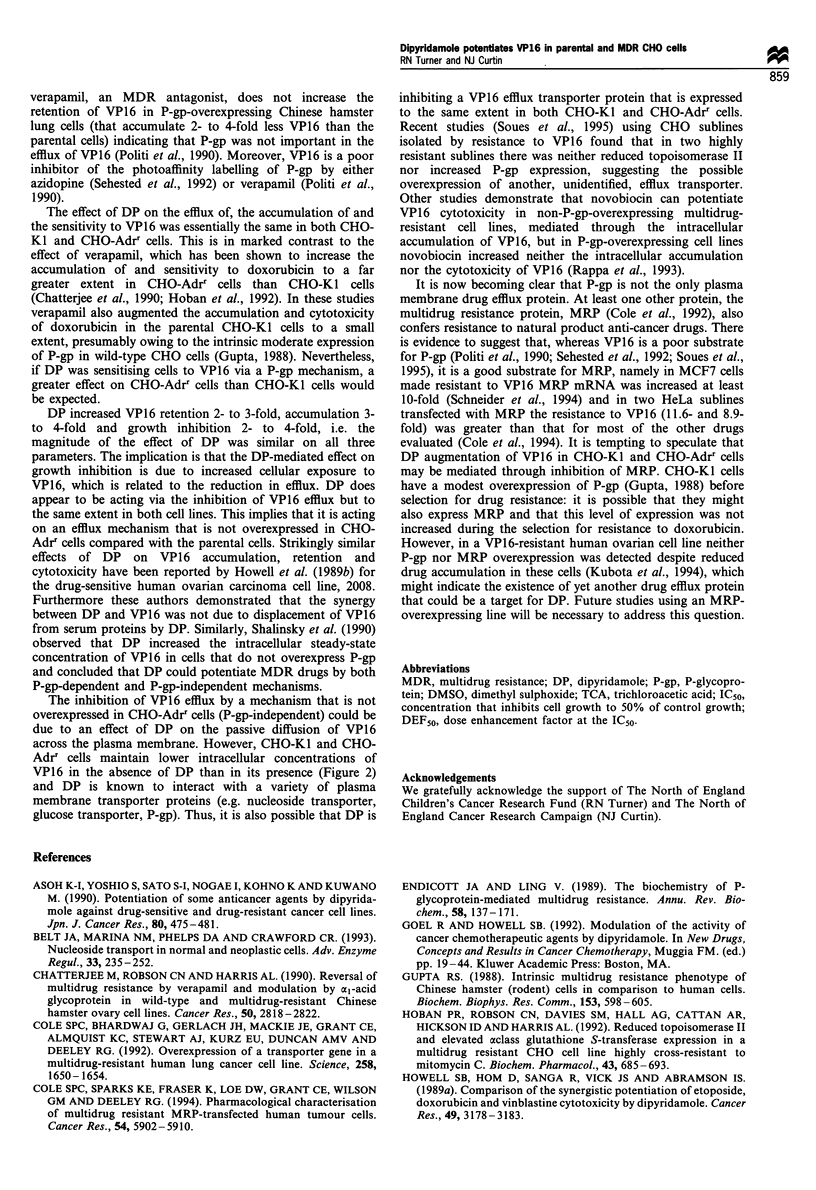Abstract
Dipyridamole (DP) has been shown to reverse multidrug resistance (MDR) via interactions with P-glycoprotein (P-gp). The effect of DP on VP16 growth inhibition was investigated in parental (CHO-K1) and MDR (CHO-Adr(r)) Chinese hamster ovary cells. CHO-Adr(r) cells were 18-fold resistant to VP16 and intracellular accumulation was 28% less than in CHO-K1 cells. DP reduced the resistance of CHO-Adr(r) to VP16 by a factor of 2-3 and caused a similar potentiation of VP16 growth inhibition in the parental cells. A time-dependent increase in intracellular VP16 accumulation, which was similar in both cell lines, was caused by DP. The intracellular retention of VP16 was increased 2- to 3-fold by DP in both cell lines. The magnitude of the effect of DP on all three parameters measured was similar (2- to 4-fold), suggesting that the increased growth inhibition was related to increased intracellular exposure to VP16 owing to the inhibition of the efflux of VP16 by DP. However, since the effect of DP was similar in both parental and P-gp-overexpressing cells it is unlikely that the potentiation of VP16 by DP is mediated via an interaction with P-gp.
Full text
PDF




Selected References
These references are in PubMed. This may not be the complete list of references from this article.
- Asoh K., Saburi Y., Sato S., Nogae I., Kohno K., Kuwano M. Potentiation of some anticancer agents by dipyridamole against drug-sensitive and drug-resistant cancer cell lines. Jpn J Cancer Res. 1989 May;80(5):475–481. doi: 10.1111/j.1349-7006.1989.tb02339.x. [DOI] [PMC free article] [PubMed] [Google Scholar]
- Belt J. A., Marina N. M., Phelps D. A., Crawford C. R. Nucleoside transport in normal and neoplastic cells. Adv Enzyme Regul. 1993;33:235–252. doi: 10.1016/0065-2571(93)90021-5. [DOI] [PubMed] [Google Scholar]
- Chatterjee M., Robson C. N., Harris A. L. Reversal of multidrug resistance by verapamil and modulation by alpha 1-acid glycoprotein in wild-type and multidrug-resistant Chinese hamster ovary cell lines. Cancer Res. 1990 May 1;50(9):2818–2822. [PubMed] [Google Scholar]
- Cole S. P., Bhardwaj G., Gerlach J. H., Mackie J. E., Grant C. E., Almquist K. C., Stewart A. J., Kurz E. U., Duncan A. M., Deeley R. G. Overexpression of a transporter gene in a multidrug-resistant human lung cancer cell line. Science. 1992 Dec 4;258(5088):1650–1654. doi: 10.1126/science.1360704. [DOI] [PubMed] [Google Scholar]
- Cole S. P., Sparks K. E., Fraser K., Loe D. W., Grant C. E., Wilson G. M., Deeley R. G. Pharmacological characterization of multidrug resistant MRP-transfected human tumor cells. Cancer Res. 1994 Nov 15;54(22):5902–5910. [PubMed] [Google Scholar]
- Endicott J. A., Ling V. The biochemistry of P-glycoprotein-mediated multidrug resistance. Annu Rev Biochem. 1989;58:137–171. doi: 10.1146/annurev.bi.58.070189.001033. [DOI] [PubMed] [Google Scholar]
- Gupta R. S. Intrinsic multidrug resistance phenotype of Chinese hamster (rodent) cells in comparison to human cells. Biochem Biophys Res Commun. 1988 Jun 16;153(2):598–605. doi: 10.1016/s0006-291x(88)81137-9. [DOI] [PubMed] [Google Scholar]
- Hoban P. R., Robson C. N., Davies S. M., Hall A. G., Cattan A. R., Hickson I. D., Harris A. L. Reduced topoisomerase II and elevated alpha class glutathione S-transferase expression in a multidrug resistant CHO cell line highly cross-resistant to mitomycin C. Biochem Pharmacol. 1992 Feb 18;43(4):685–693. doi: 10.1016/0006-2952(92)90231-7. [DOI] [PubMed] [Google Scholar]
- Howell S. B., Hom D. K., Sanga R., Vick J. S., Chan T. C. Dipyridamole enhancement of etoposide sensitivity. Cancer Res. 1989 Aug 1;49(15):4147–4153. [PubMed] [Google Scholar]
- Howell S. B., Hom D., Sanga R., Vick J. S., Abramson I. S. Comparison of the synergistic potentiation of etoposide, doxorubicin, and vinblastine cytotoxicity by dipyridamole. Cancer Res. 1989 Jun 15;49(12):3178–3183. [PubMed] [Google Scholar]
- Kubota N., Nishio K., Takeda Y., Ohmori T., Funayama Y., Ogasawara H., Ohira T., Kunikane H., Terashima Y., Saijo N. Characterization of an etoposide-resistant human ovarian cancer cell line. Cancer Chemother Pharmacol. 1994;34(3):183–190. doi: 10.1007/BF00685075. [DOI] [PubMed] [Google Scholar]
- Plagemann P. G., Wohlhueter R. M., Woffendin C. Nucleoside and nucleobase transport in animal cells. Biochim Biophys Acta. 1988 Oct 11;947(3):405–443. doi: 10.1016/0304-4157(88)90002-0. [DOI] [PubMed] [Google Scholar]
- Politi P. M., Arnold S. T., Felsted R. L., Sinha B. K. P-glycoprotein-independent mechanism of resistance to VP-16 in multidrug-resistant tumor cell lines: pharmacokinetic and photoaffinity labeling studies. Mol Pharmacol. 1990 Jun;37(6):790–796. [PubMed] [Google Scholar]
- Ramu A., Spanier R., Rahamimoff H., Fuks Z. Restoration of doxorubicin responsiveness in doxorubicin-resistant P388 murine leukaemia cells. Br J Cancer. 1984 Oct;50(4):501–507. doi: 10.1038/bjc.1984.207. [DOI] [PMC free article] [PubMed] [Google Scholar]
- Rappa G., Lorico A., Sartorelli A. C. Reversal of etoposide resistance in non-P-glycoprotein expressing multidrug resistant tumor cell lines by novobiocin. Cancer Res. 1993 Nov 15;53(22):5487–5493. [PubMed] [Google Scholar]
- Schmoll H. J., Harstrick A., Köhne-Wömpner C. H., Schöber C., Wilke H., Poliwoda H. Modulation of cytotoxic drug activity by dipyridamole. Cancer Treat Rev. 1990 Dec;17 (Suppl A):57–65. doi: 10.1016/0305-7372(90)90017-a. [DOI] [PubMed] [Google Scholar]
- Schneider E., Horton J. K., Yang C. H., Nakagawa M., Cowan K. H. Multidrug resistance-associated protein gene overexpression and reduced drug sensitivity of topoisomerase II in a human breast carcinoma MCF7 cell line selected for etoposide resistance. Cancer Res. 1994 Jan 1;54(1):152–158. [PubMed] [Google Scholar]
- Sehested M., Friche E., Jensen P. B., Demant E. J. Relationship of VP-16 to the classical multidrug resistance phenotype. Cancer Res. 1992 May 15;52(10):2874–2879. [PubMed] [Google Scholar]
- Shalinsky D. R., Andreeff M., Howell S. B. Modulation of drug sensitivity by dipyridamole in multidrug resistant tumor cells in vitro. Cancer Res. 1990 Dec 1;50(23):7537–7543. [PubMed] [Google Scholar]
- Skehan P., Storeng R., Scudiero D., Monks A., McMahon J., Vistica D., Warren J. T., Bokesch H., Kenney S., Boyd M. R. New colorimetric cytotoxicity assay for anticancer-drug screening. J Natl Cancer Inst. 1990 Jul 4;82(13):1107–1112. doi: 10.1093/jnci/82.13.1107. [DOI] [PubMed] [Google Scholar]
- Souès S., Laval F., Charcosset J. Y. Mechanisms of resistance to combinations of vincristine, etoposide and doxorubicin in Chinese hamster ovary cells. Br J Cancer. 1995 Mar;71(3):489–497. doi: 10.1038/bjc.1995.99. [DOI] [PMC free article] [PubMed] [Google Scholar]
- Wigler P. W., Patterson F. K. Inhibition of the multidrug resistance efflux pump. Biochim Biophys Acta. 1993 Oct 29;1154(2):173–181. doi: 10.1016/0304-4157(93)90010-l. [DOI] [PubMed] [Google Scholar]


